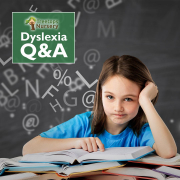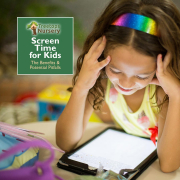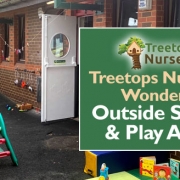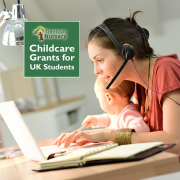Bird Feeder Activity for Kids
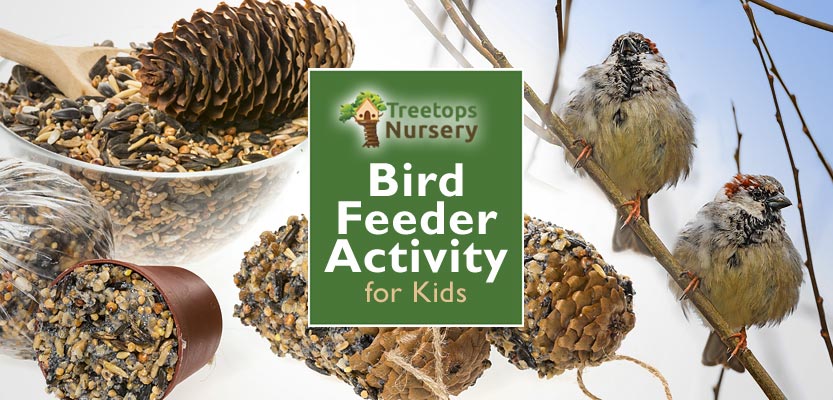
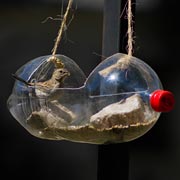 As promised in our recent posts ‘How to Attract Garden Wildlife – for Under-5s’ and ‘Bee-Friendly Flower Growing for Kids’, we follow up today with a guide to bird feeders that children can enjoy making at home. It’s a creative and educational activity that children of all ages will enjoy. And, With the right location and bird food, the home-made bird feeders are sure to attract a multitude of beautiful birds to the garden for the children to enjoy and learn from.
As promised in our recent posts ‘How to Attract Garden Wildlife – for Under-5s’ and ‘Bee-Friendly Flower Growing for Kids’, we follow up today with a guide to bird feeders that children can enjoy making at home. It’s a creative and educational activity that children of all ages will enjoy. And, With the right location and bird food, the home-made bird feeders are sure to attract a multitude of beautiful birds to the garden for the children to enjoy and learn from.
With any of these feeders, though, don’t expect birds to come right away. They’ll be suspicious of anything new in the garden for a while, so children need to be patient while the birds learn to trust the new addition. Once they have accepted it, though, they’ll come again and again if suitable food continues to be supplied.
Apple Feeders
 Starting with the most simple bird feeder of all, children can make an apple bird feeder. All they need is an apple and something to hold it. So, a piece of string threaded through it would be one easy solution for a hanging apple feeder (an adult may need to supervise for safety reasons). Another would be to spear the apple onto a vertical stick (see example photo), bamboo cane or even a suitably angled tree branch/twig. Again, adult supervision would be wise so the child does not hurt itself. Try peeling off some of the skin to show the apple flesh and this may encourage birds to have a peck. Apple feeders may be particularly popular with blackbirds.
Starting with the most simple bird feeder of all, children can make an apple bird feeder. All they need is an apple and something to hold it. So, a piece of string threaded through it would be one easy solution for a hanging apple feeder (an adult may need to supervise for safety reasons). Another would be to spear the apple onto a vertical stick (see example photo), bamboo cane or even a suitably angled tree branch/twig. Again, adult supervision would be wise so the child does not hurt itself. Try peeling off some of the skin to show the apple flesh and this may encourage birds to have a peck. Apple feeders may be particularly popular with blackbirds.
Pine Cone Feeders
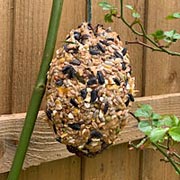 These are easy and fun for children to make. All they need is a suitable pine cone that’s ‘opened’, some bird seed and either peanut butter, suet or lard.* Children simply need to paste the peanut butter, suet or lard into the spaces between the pine cone scales, then roll the entire thing in bird seed, which will stick, and suspend the new feeder by string. Easy!
These are easy and fun for children to make. All they need is a suitable pine cone that’s ‘opened’, some bird seed and either peanut butter, suet or lard.* Children simply need to paste the peanut butter, suet or lard into the spaces between the pine cone scales, then roll the entire thing in bird seed, which will stick, and suspend the new feeder by string. Easy!
If no pine cone is available, the same approach can be used but using a chunk or thick slice of bread instead of the pine cone. However, we do not recommend it as bread will go mouldy if left outside for more than a day or two, and this can harm or even kill birds.
Suet* Flower Pot Seed Cakes
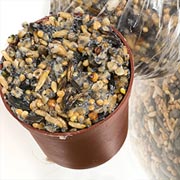 Suet* or lard* can also be used to make flower pot seed cakes. However, this will require the help of an adult because it will need to be melted on the hot stove before being mixed with bird seed. While still molten, it can be poured into flower pots or used yoghurt pots, where it will set solid, once cool. Children can take over only once it’s safe to do so. A piece of string can be then used to thread through and hang the seed flower pot or yoghurt pot in a suitable place to attract birds.
Suet* or lard* can also be used to make flower pot seed cakes. However, this will require the help of an adult because it will need to be melted on the hot stove before being mixed with bird seed. While still molten, it can be poured into flower pots or used yoghurt pots, where it will set solid, once cool. Children can take over only once it’s safe to do so. A piece of string can be then used to thread through and hang the seed flower pot or yoghurt pot in a suitable place to attract birds.
*Peanut Butter, Suet & Lard — Important Note
*If using peanut butter, ensure it’s fresh, salt-, sugar- and flavouring-free (or use a good brand of peanut butter made especially for birds). Both smooth and crunchy are suitable but smooth is a little safer for baby birds during breeding season.
With regard to suet, use only proper beef suet, from cows. It should be hard, not imprint if squeezed but instead crumble when handled. Avoid fake suets as they are not safe for birds.
If using lard, ensure it’s pure lard, is hard at room temperature and remains solid when it’s even warmer — otherwise it may simply melt on hot, sunny days, and this can be a bio hazard for birds. Like suet, pure lard should also not imprint when squeezed.
Plastic Bottle Feeders
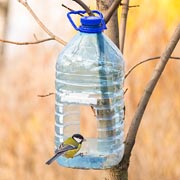 These are amongst the most adaptable of home-made bird feeders. As the photographs on this article show, they can be hung vertically or horizontally, depending on the way they’ve been adapted. They can also be used to house bird seed/food or drinking water. Birds do need fresh drinking water and, by the way, will often appreciate spring water more than tap water in areas where there is more chemical in the latter. Take a look at the photos to see what’s possible with recycled water bottles — children can get quite inventive!
These are amongst the most adaptable of home-made bird feeders. As the photographs on this article show, they can be hung vertically or horizontally, depending on the way they’ve been adapted. They can also be used to house bird seed/food or drinking water. Birds do need fresh drinking water and, by the way, will often appreciate spring water more than tap water in areas where there is more chemical in the latter. Take a look at the photos to see what’s possible with recycled water bottles — children can get quite inventive!
Milk/Juice Carton Feeders
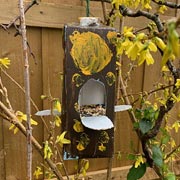 Bird feeders can be great fun when made from used juice or milk cartons. As the example shows, a few simple cuts (with adult supervision) are all that’s needed to form landing stages where birds can land in order to get to the seeds inside. String for hanging can be trapped at the top by using the screw-on lid, or using a hole made carefully/safely in the centre of the lid. Simple! What makes carton bird feeders extra fun is the fact that they can be painted by children. This will stimulate their creativity as well as making the feeders attractive — or even camouflaged.
Bird feeders can be great fun when made from used juice or milk cartons. As the example shows, a few simple cuts (with adult supervision) are all that’s needed to form landing stages where birds can land in order to get to the seeds inside. String for hanging can be trapped at the top by using the screw-on lid, or using a hole made carefully/safely in the centre of the lid. Simple! What makes carton bird feeders extra fun is the fact that they can be painted by children. This will stimulate their creativity as well as making the feeders attractive — or even camouflaged.
Monkey Nut Feeders
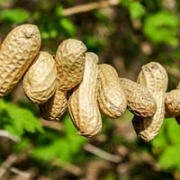 Another very simple type of bird feeder that children can make is a hanging monkey nut feeder. All children (or a supervising adult) need to do is to thread string through part of the outer husk of each monkey nut, forming a chain of nuts. This can then be strung between the branches of a tree or other suitable place. Birds including tits will easily peck through the outer husk to get to the nuts inside. Squirrels may also visit!
Another very simple type of bird feeder that children can make is a hanging monkey nut feeder. All children (or a supervising adult) need to do is to thread string through part of the outer husk of each monkey nut, forming a chain of nuts. This can then be strung between the branches of a tree or other suitable place. Birds including tits will easily peck through the outer husk to get to the nuts inside. Squirrels may also visit!
Please note that monkey nuts (peanuts that are in their outer cases) should be unroasted. Before serving them to birds, an adult should break a few open to ensure that there is no fungus between the outer case and the nut itself. The fungus called aflatoxin is harmful to both birds and children as it’s a carcinogen (i.e. causes cancer).
Choosing Your Bird Food
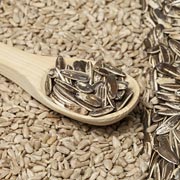 Choosing the right bird food is critically important for the success of bird feeders. There are many types of seed to choose from and different seeds will appeal to different bird species. However, to get started, we found that children can’t go wrong with just two or three key bird foods:
Choosing the right bird food is critically important for the success of bird feeders. There are many types of seed to choose from and different seeds will appeal to different bird species. However, to get started, we found that children can’t go wrong with just two or three key bird foods:
Sunflower hearts and/or mild cheddar cheese, each of which are easily and inexpensively available from supermarkets and online. These are extremely popular, especially amongst robins, various tits, sparrows, dunnocks, nuthatches, woodpeckers blackbirds, starlings and thrushes.
If going with cheese ensure it’s grated or chopped into tiny pieces that small birds will be able to easily swallow. Also ensure it’s fresh and has not got any mould on it (this can be dangerous to birds).
‘Robin Peanut Cakes‘ are also a huge hit with the same feathered friends, especially robins plus the addition of long-tailed tits, which are perhaps amongst the cutest of all UK birds — they are adorable! Robin Peanut Cakes are available from the physical and online shops of The National Trust, Ocado, Morrisons and many others, including Amazon.
Bread should ideally be a last resort (it’s not actually that good for birds) or, if used, it must be fresh, mould-free, torn up into tiny pieces and never left to rot. So, little and often is better than putting out a large amount all in one go when feeding birds bread, otherwise it can quickly go mouldy and harm the birds.
Locating Bird Feeders
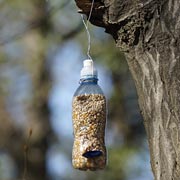 Children and adults should look for a safe and suitable place to site their newly-made bird feeders. To protect from cats and other ground-level predators, bird feeders should be at least 1.5 metres above ground level, while remaining low enough to allow for easy refilling. To protect from attack from above by birds of prey, bird feeders should be located ideally under some kind of ‘overhang’. For example, under the branches or canopy of a mature tree, or below protruding eves of a house or building. Children may well find that the bird feeders are more popular if these rules are followed.
Children and adults should look for a safe and suitable place to site their newly-made bird feeders. To protect from cats and other ground-level predators, bird feeders should be at least 1.5 metres above ground level, while remaining low enough to allow for easy refilling. To protect from attack from above by birds of prey, bird feeders should be located ideally under some kind of ‘overhang’. For example, under the branches or canopy of a mature tree, or below protruding eves of a house or building. Children may well find that the bird feeders are more popular if these rules are followed.
Hygiene for Birds
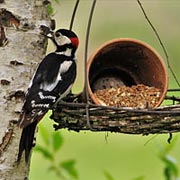 For birds, the bird feeders will need to be cleaned regularly so that disease is not spread throughout the bird populations. The RSPB has some useful guidelines here.
For birds, the bird feeders will need to be cleaned regularly so that disease is not spread throughout the bird populations. The RSPB has some useful guidelines here.
Bird drinking water should also be regularly changed and any vessel holding it also cleaned from time to time. Whether near drinking water or food, bird droppings are a particular hazard for birds, as these can spread disease and parasites.
Hygiene & Safety for Children
For children, particularly the very young, an adult should supervise the feeder-making activities, cleanliness around the bird feeders and even hygiene around bird food.
Adults may need to step in during the feeder-making process itself if materials need to be cut or punctured with scissors or a knife. These are especially hazardous for the youngest children who are not yet fully dextrous or good with hand-eye coordination.
After touching or cleaning used or dirty bird feeders, children should wash hands with soap and water or, better still, wear rubber gloves during the process. Any cleaning of feeders should ideally be done outside and any handling of cleaning chemicals (see RSPB link above) should be done by the supervising adult, not the child.
Last but not least, nuts are a known allergen to an unlucky few. Avoid them unless you know for certain that your child is not allergic to them.
Nature is So Good for Children
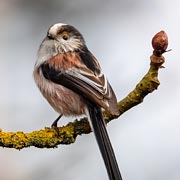 Children learn a huge amount and benefit enormously from nature, particularly the very young, so making bird feeders to attract wild birds is a very worthwhile activity. It also supports several aspects of the EYFS curriculum, including understanding the world, nurturing creativity and much more. What’s more, it need not cost much, if any money to accomplish and will also help our feathered friends, particularly during months when there is precious little natural food around for them.
Children learn a huge amount and benefit enormously from nature, particularly the very young, so making bird feeders to attract wild birds is a very worthwhile activity. It also supports several aspects of the EYFS curriculum, including understanding the world, nurturing creativity and much more. What’s more, it need not cost much, if any money to accomplish and will also help our feathered friends, particularly during months when there is precious little natural food around for them.
Do You Want the Best Childcare in Willesden for your Child?
Or perhaps you need high quality childcare near Harlesden, Willesden Green or Kensal Green.
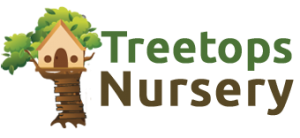 We are Treetops Nursery, one of the best nurseries and pre-schools in Willesden, and also near to Willesden Green, Kensal Green, Harlesden and London NW10. We’re independently rated by Ofsted as a Good early years provider in every category, so you know your baby or child under five will be in safe and capable hands. To register your child for a nursery/pre-school place, arrange a tour of the setting or find answers to any questions you may have, please contact us:
We are Treetops Nursery, one of the best nurseries and pre-schools in Willesden, and also near to Willesden Green, Kensal Green, Harlesden and London NW10. We’re independently rated by Ofsted as a Good early years provider in every category, so you know your baby or child under five will be in safe and capable hands. To register your child for a nursery/pre-school place, arrange a tour of the setting or find answers to any questions you may have, please contact us:

